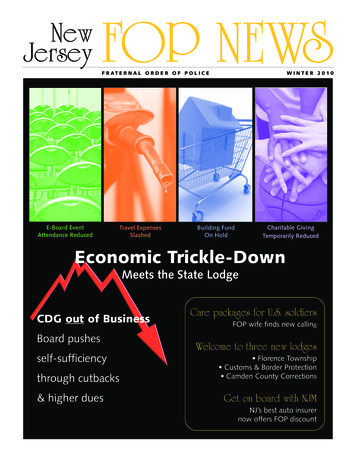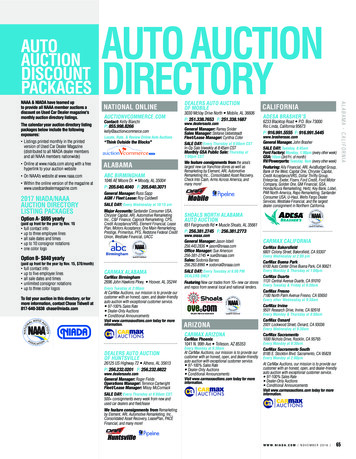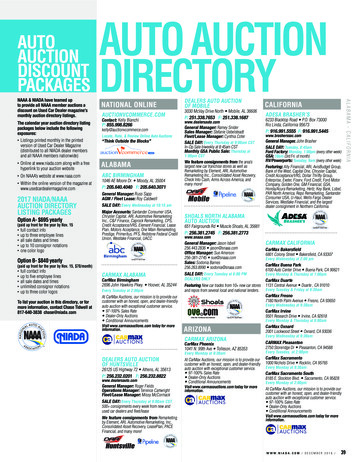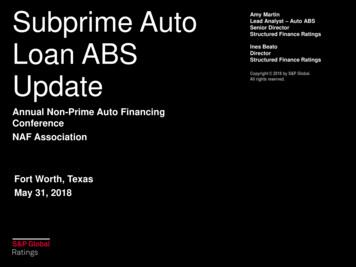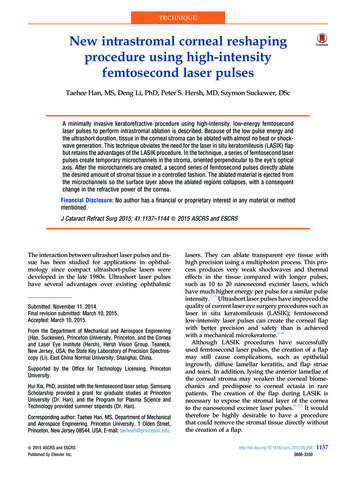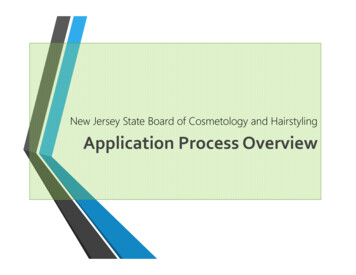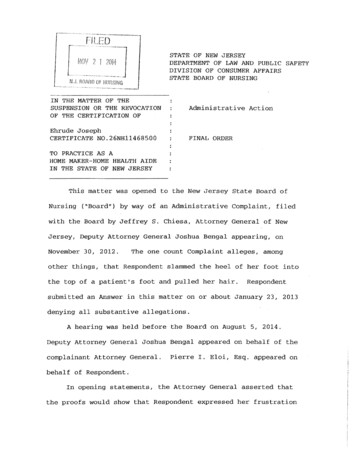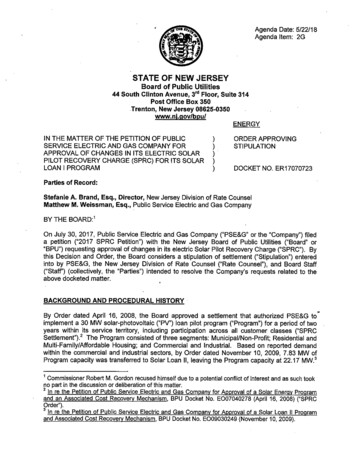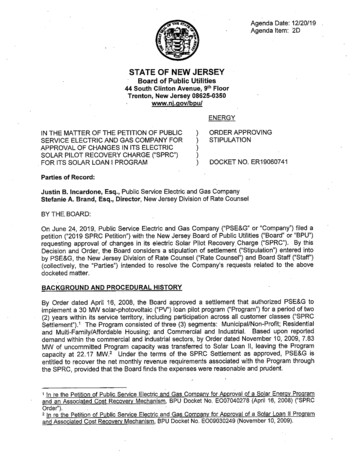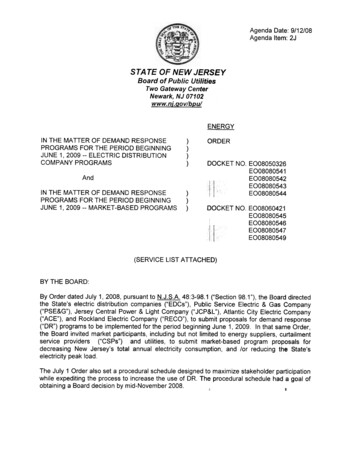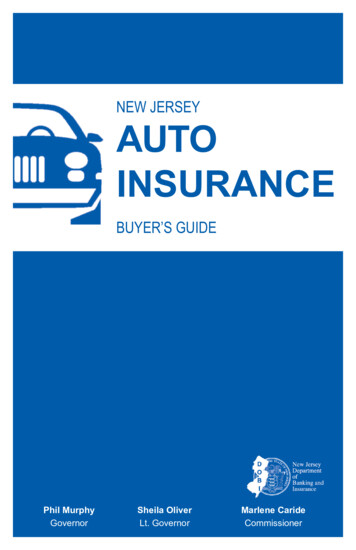
Transcription
NEW JERSEYAUTOINSURANCEBUYER’S GUIDEPhil MurphyGovernorSheila OliverLt. GovernorMarlene CarideCommissioner
WHERE DO I START? . 1UNDERSTANDING YOUR POLICY . 2-6Types of CoveragesStandard and Basic PoliciesWHAT'S INSIDEWhat are Limits and Deductibles?UNDERSTANDING YOUR OPTIONS . 6-11Personal Injury Protection (PIP)Uninsured/Underinsured Motorist CoverageComprehensive Coverage/Collision CoverageThe Right to SuePOLICY OPTIONS CHART. 12WHERE TO GET MORE INFORMATION ANDHELP . 13
WHERE DO I START?Car insurance is required in New Jersey. Whether you are buying a newinsurance policy or renewing your current policy, you must make many decisionsabout what coverage you need and how much you can pay. The followingguide outlines how to make choices that work for you.UNDERSTAND YOUR NEEDS. Do you rent or own your own home?Do you have assets to protect (including income from a job)? Will your ownhealth insurance cover auto accident injuries? How much insurance coveragecan you afford? These are some of the questions you should ask yourselfbefore choosing a specific coverage plan.UNDERSTAND YOUR OPTIONS. Use this guide to learn about thewords and phrases used in auto policies. Know the many coverage options.Review the different benefits of each option.UNDERSTAND CONSUMER PROTECTIONS . As a New Jerseyauto insurance consumer, you have rights. You have a right to fair and equaltreatment, and you have the right to get the information you need to makeinformed decisions. Agents, brokers and companies must inform you of your coverageoptions when applying for a new policy, or at any time upon yourrequest if you are already insured. You have the right to know howeach choice may affect what you pay and what your benefits wouldbe in the event of an accident. You always have the right to ask aboutadditional options. You can shop for auto insurance at any time – not just when yourpolicy is up for renewal, and if you find a better price, you can cancelyour old policy and seek a refund of your unused premium. You have the right to change your coverages and policy limits atany time, even if you are not near your renewal date. If you selectoptions that save you money, you have a right to a refund of yourunused premium within 60 days.1
UNDERSTANDING YOUR POLICYTypes of CoveragesInsurance policies use terms that may be unfamiliar to the average driver. It isuseful to understand what these terms mean so you can make better, moreinformed decisions about your coverage.COVERAGES — Your auto insurance policy is divided into differentcoverages based on the type of claim that will be paid to you or others.These COVERAGES are:PERSONAL INJURY PROTECTION — Otherwise known as “PIP,”this is your medical coverage for injuries you (and others) suffer in an autoaccident. PIP pays if you or other persons covered under your policy areinjured in an auto accident. It is sometimes called “no-fault” coverage becauseit pays your own medical expenses no matter who caused the auto accident.PIP has two parts — (1) coverage for the cost of treatment you receive fromhospitals, doctors and other medical providers and any medical equipmentthat may be needed to treat your injuries and (2) reimbursement for certainother expenses you may have because you are hurt, such as lost wages andthe need to hire someone to take care of your home or family.LIABILITY — This coverage pays others for damages from an auto accidentthat you cause. It also pays for a lawyer to defend you if you are sued fordamages that you cause.There are two kinds of liability coverage: BODILY INJURY andPROPERTY DAMAGE.BODILY INJURY LIABILITY COVERAGE — Pays for claims andlawsuits by people who are injured or die as a result of an auto accident youcause. (See page 10 for lawsuit options). It compensates others for pain,suffering and economic damages, such as lost wages.This coverage is typically given as two separate dollar amounts: (1) an amountpaid per individual and (2) an amount paid for total injuries to all peopleinjured in any one accident that you cause. It can sometimes be purchased asa combined single limit, which offers a maximum limit of protection peraccident of bodily injury and property damage liability combined.2
s of Coverages continuedPROPERTY DAMAGE LIABILITY COVERAGE — Pays for claimsand lawsuits by people whose property is damaged as a result of an autoaccident you cause. (May also be purchased as a combined single limitwith bodily injury liability coverage.)UNINSURED MOTORIST COVERAGE — Pays you for propertydamage or bodily injury if you are in an auto accident caused by an uninsuredmotorist.UNDERINSURED MOTORIST COVERAGE — Pays you for propertydamage or bodily injury if you are in an auto accident caused by a driver whois insured, but who has less coverage than your underinsured motoristcoverage.EXAMPLE ofUNDERINSUREDMOTORISTCOVERAGEJane purchases 100,000 in liabilitycoverage and 100,000 in underinsuredmotorist coverage. Sam purchases only 15,000 in liability coverage. Sam crasheshis car into Jane’s car, causing 25,000 indamages. Sam’s insurance company pays 15,000 of the damages, while Jane’sinsurance company pays the remaining 10,000 from her underinsured motoristcoverage.COLLISION COVERAGE — Pays for damage to your vehicle as theresult of a collision with another car or other object.COMPREHENSIVE COVERAGE — Pays for damage to your vehiclethat is not a result of a collision, such as theft of your car, vandalism, flooding,fire or a broken windshield. However, it will pay if you collide with an animal.3
dard and Basic PoliciesThere are two common types of auto insurance policies in New Jersey. Theyare referred to as STANDARD and BASIC. Both offer options as well.STANDARD POLICY — The Standard Policy provides anumber of different coverage options and the opportunity to buyadditional protection. The Standard Policy is the type of policychosen by most New Jersey drivers.BASIC POLICY — The Basic Policy usually costssignificantly less than a Standard Policy, but provides limitedbenefits. It is not for everyone, but it does provide enough coverageto meet the minimum insurance requirements of New Jersey law.The Basic Policy could be an option for those with few familyresponsibilities and few assets to protect (including income froma job).See chart on page 5 for differences between the STANDARD and BASICpolices.SPECIAL POLICYFOR MEDICAIDRECIPIENTS ONLY4The Special Policy is a new initiativeto help make limited auto insurancecoverage available to drivers who areeligible for Federal Medicaid withhospitalization. Such drivers canobtain a medical coverage-onlypolicy at a cost of 365 a year. Formore information, ask your agent orcompany representative or call theDepartment of Banking andInsurance at 1-800-446-7467.
dard and Basic Policies continuedThe chart below compares the differences between the STANDARD and D POLICYBASIC POLICYAs low as: 15,000 per person, 30,000 per accidentCoverage is not included,but 10,000 for all persons,per accident, is available asan optionAs high as: 250,000 per person, 500,000 per accidentPROPERTYDAMAGE LIABILITYAs low as: 5,000 per accident 5,000 per accidentAs high as: 100,000 or morePERSONAL IN JUR YPR OTECTIONAs low as: 15,000 per person oraccident 15,000 per person,per accidentAs high as: 250,000 or moreUp to 250,000 for certaininjuries* regardless ofselected limitUp to 250,000 for certaininjuries*Coverage is available up toamounts selected for liabilitycoverageNoneCOLLISIONAvailable as an optionAvailable as an option (fromsome insurers)COMPREHENSIVEAvailable as an optionAvailable as an option (fromsome rmanent or significant brain injury, spinal cord injury or disfigurement or formedically necessary treatment of other permanent or significant injuries renderedat a trauma center or acute care hospital immediately following an accident anduntil the patient is stable, no longer requires critical care and can be transferred toanother facility in the judgment of the physician.5
UNDERSTANDINGYOURYOURPOLICYPOLICYUNDERSTANDINGWhat are Policy Limits and Deductibles?LIMITS — The maximum dollar amount the insurer will pay following anauto accident. Limits vary with each coverage within the policy.DEDUCTIBLES —Payments you have tomake before the insurerpays. For example, a 750 deductible meansthat you pay the first 750of each claim.EXAMPLEJohn has a car accident. Hisrepair shop estimates thecost of repairs at 2,000.John pays 750 of the billand his insurance companypays the OPTIONSPersonal Injury Protection (PIP)Choosinga higherdeductiblemay saveyou moneyon yourpremium.DEDUCTIBLE OPTIONS — In addition to anysavings you may realize from how much coverageyou buy, deductibles also provide savingsopportunities. Cost savings can be achieved bychoosing higher deductibles. Thus, if you feel youneed a high level of PIP coverage but want to reduceyour premium, you can save money by agreeing topay more out-of-pocket through a higher deductibleif you are injured in an auto accident. Your insurerwill pay the medical bills over the deductible amountyou choose. No matter what deductible you choose,there is also a 20 percent co-payment for medicalexpenses between the deductible selected and 5,000. That means you pay 20 percent, and yourinsurer pays 80 percent.
sonal Injury Protection continuedEXAMPLESam and Jane each have an accident that results in 10,000 ofmedical expenses. Sam chose the minimum 250 deductible. He paysthe 250 deductible plus 950 (20 percent of the 4,750 that is leftof the first 5,000) and the insurer pays the remaining 8,800). Janechose the 2,500 PIP deductible for a 25 percent reduction in thePIP premium. She pays the first 2,500 as the deductible. She alsopays 500 (20 percent of the 2,500 that is left of the first 5,000)and the insurer pays the remaining 7,000.HEALTH CARE PRIMARY — Cost savings can also be achieved byusing your own health insurance as a primary source of coverage in the caseof injury related to an auto accident. Before selecting this option, you shouldfind out if your health insurance will cover auto accident injuries and howmuch coverage is provided. MEDICARE and MEDICAID cannot be usedfor the Health Care Primary option.EXTRA PIP PACKAGE COVERAGE — These are additional benefitoptions provided under the STANDARD POLICY.INCOME CONTINUATION — If you cannot work due to accidentrelated injuries, this coverage pays lost wages, less Temporary DisabilityBenefits you may receive if your disability prevents you from working, upto the amount you select.ESSENTIAL SERVICES — Pays for necessary services that younormally do yourself, such as cleaning your house, mowing your lawn,shoveling snow or doing laundry, if you are injured in an auto accident.DEATH BENEFIT — In the case of death, family members or estateswill receive any benefits not already collected under the incomecontinuation and essential services coverages.FUNERAL EXPENSE BENEFIT — Pays for reasonable funeralexpenses up to the limit you select if you die as a result of an auto accident.7
nsured/Underinsured Motorist CoverageUNINSURED MOTORIST COVERAGE — Pays you if you are in anauto accident caused by a driver who does not have the minimum level ofinsurance required by law. Claims thatyou would have made against theuninsured driver who caused theIf you choose theaccident are paid by your own policy.STANDARDUninsured motorist coverage doesPOLICY:not pay benefits to the uninsureddriver.A minimum amount ofUninsured/UnderinsuredUNDERINSURED MOTORISTMotorist Coverage isCOVERAGE — Pays you if yourequired. You can purchaseare in an auto accident caused by ahigher limits if you want moredriver who is insured, but who has lesscoverage.coverage than your underinsuredmotorist coverage. Damages greaterthan the limits of the other driver’spolicy are covered by your policy up to the difference between the limits ofyour underinsured motorist coverage and the other driver’s policy ONSComprehensive Coverage/Collision CoverageCOMPREHENSIVE (also known as comp or other than collision) andCOLLISION coverage are not required by law, but may be requiredunder the terms of an automobile leasing or financing contract.Collision coverage pays you for damage that you cause to your automobile.You can also make a claim under your own collision coverage for damage toyour car from an auto accident you did not cause. This may take less time8
prehensive Coverage/Collision Coverage continuedthan making a property damage liability claim against the driver who causedthe auto accident. Your insurer then seeks reimbursement (subrogation) fromthe insurer of the driver who caused the auto accident.Comprehensive coverage pays you if your automobile is stolen or for damageto your automobile caused by things not covered under collision coverage,such as vandalism, flooding, fire, a broken windshield or damage from ananimal.DEDUCTIBLE — The STANDARD deductible for comprehensive andcollision coverage is 750. Higher and lower deductibles are available asoptions. Higher deductibles can reduce your premium.NAMED DRIVER EXCLUSION — Prevents certain drivers on yourpolicy from being covered by collision and/or comprehensive coverage on aspecific automobile. This can lower your premium, but if the excluded driveroperates the automobile and is involved in an auto accident, you are not insuredfor collision and/or comprehensive coverage; which means you could bepersonally responsible.If you choose theSTANDARD POLICY:Comprehensiveand CollisionCoverage are always available asoptions of the STANDARD POLICY.If you choose theBASIC POLICY:Insurers are not required to provide theseoptions in the BASIC POLICY.9
UNDERSTANDINGYOURPOLICYUNDERSTANDINGYOUROPTIONSThe Right to Sue For the STANDARD POLICY, you must make a choice about the rightsyou will have if you are injured in an automobile accident. (The BASICPOLICY includes the LIMITED RIGHT TO SUE option.)IMPORTANTThe choice you make affects howmuch your insurance will cost andwhat claims will be paid in theevent of an accident.The choice you make regarding yourright to sue another driver applies toyou, your spouse, children and otherrelatives living with you who are notcovered under another automobileinsurance policy.The UNLIMITED RIGHT TO SUEand LIMITED RIGHT TO SUEoptions only cover lawsuits for “painand suffering” or non-economiclosses. Your medical expenses andsome economic losses for injuries inauto accidents will be paid up to thelimits of your PIP coverage and arenot affected by the choice you makehere.10
UNDERSTANDINGYOURPOLICYUNDERSTANDINGYOUROPTIONSThe Right to Sue continuedUNLIMITED RIGHT TO SUE — Under the No Limitation on LawsuitOption, you retain the right to sue the person who caused an auto accident forpain and suffering for any injury.LIMITED RIGHT TO SUE — By choosing the Limitation on LawsuitOption, you agree not to sue the person who caused an auto accident foryour pain and suffering unless you sustain one of the permanent injuries listedbelow: (Choosing this option does not affect your ability to sue for economicdamages such as medical expenses and lost wages.) loss of body part significant disfigurement or significant scarring a displaced fracture loss of a fetus permanent injury (Any injury shall be considered permanent whenthe body part or organ, or both, has not healed to function normallyand will not heal to function normally with further medical treatmentbased on objective medical proof.) deathWARNING: Insurance companies or theirproducers or representatives shall not be heldliable for your choice of lawsuit option (LimitedRight to Sue or Unlimited Right to Sue) or foryour choices regarding amounts and types ofcoverage. You cannot sue an insurance companyor its producers or representatives if the LimitedRight to Sue option is imposed by law becauseno choice was made on the coverage selectionform. Insurers and their producers orrepresentatives can lose this limitation on liabilityfor failing to act in accordance with the law . SeeN.J.S.A. 17:28-1.9 for more information.11
UNDERSTANDINGYOUR POLICYPOLICYOPTIONS CHARTCOVERAGESLIABILITY - Bodily Injuryand Property DamageOptions ThatWhat MostOptions ThatCost Less Drivers ChooseCost More 35,000; 50,000; 100,000 300,000 500,000 250,000Some insurersmay offer morethan 250,000 500; 1,000; 2,000; 2,500 250---You can declinethe Extra PIPPackageMost consumerschoose theExtra PIP PackagePackages maybe available inhigher amountsPERSONAL INJURYPROTECTION (PIP)Medical Expense LimitMedical DeductibleExtra PIP Options:Income Continuation,Essential Services,Death Benefit andFuneral ExpenseBenefitHealth Insurer forPIP OptionUNINSURED/UNDERINSUREDMOTORIST COVERAGE 15,000; 50,000; 75,000; 150,000Choose your own Most consumers dohealth insurernot choose theirown health insurer--- 35,000; 50,000; 100,000 300,000 500,000COLLISIONCOVERAGEDEDUCTIBLE 750; 1,000; 1,500; 2,000 500 50; 100; 150; 200; 250COMPREHENSIVECOVERAGEDEDUCTIBLE 750; 1,000; 1,500; 2,000 500 50; 100; 150; 200; 250LAWSUIT OPTION---Limitation onLawsuit OptionNo Limitation onLawsuit Option12
WHERETO GET MOREUNDERSTANDINGYOUR POLICYINFORMATION AND HELPThis Buyer’s Guide is intended to provide generalinformation to help you make coverage choices. It is not asubstitute for the policy language, which governs.Additional information regarding coverages or premiumsis available from the insurer or producer.(Insurers that write at least two percent of the New Jerseyprivate passenger automobile market shall provide a toll-freenumber for insureds.)Contact the Dep artment of Banking and Insuranceon the web:www.dobi.nj.govby phone:(609) 292-7272or the Consumer Hotline at 1-800-446-7467by mail at:NJ DOBIP.O. Box 471Trenton, NJ 08625-0471or in person at:NJ DOBI20 West State StreetTrenton, NJ 0860813
Insurance policies use terms that may be unfamiliar to the average driver. It is useful to understand what these terms mean so you can make better, more informed decisions about your coverage. COVERAGES — Your auto insurance policy is divided into different coverages based on the ty
